Harvesting fruit, vegetables or flowers at your local U-Pick farm is the next best thing to having your own orchard and garden. Not only do you benefit from fresher-than-fresh produce but you also support local growers and farmers.
What’s more, visiting a pick-your-own farm is a great opportunity to get close to nature―whether it’s a strawberry field like the one I visited recently at Washington Farms…
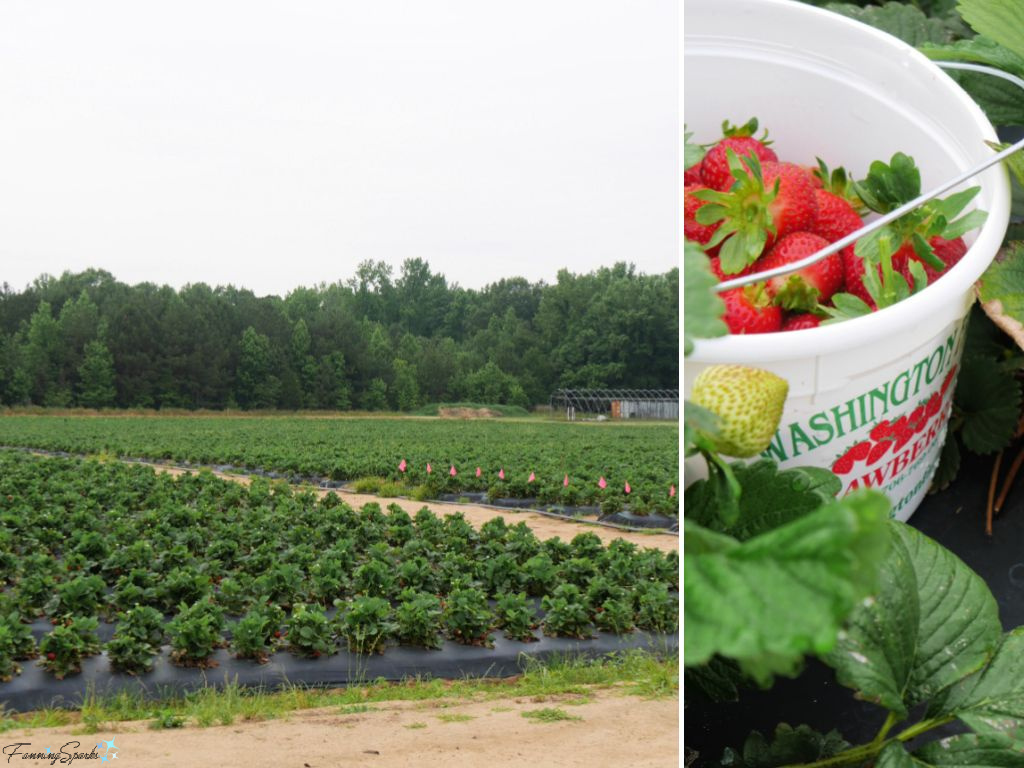
… or a meadow of blooming flowers like these I explored last week at Big Hart Farm…
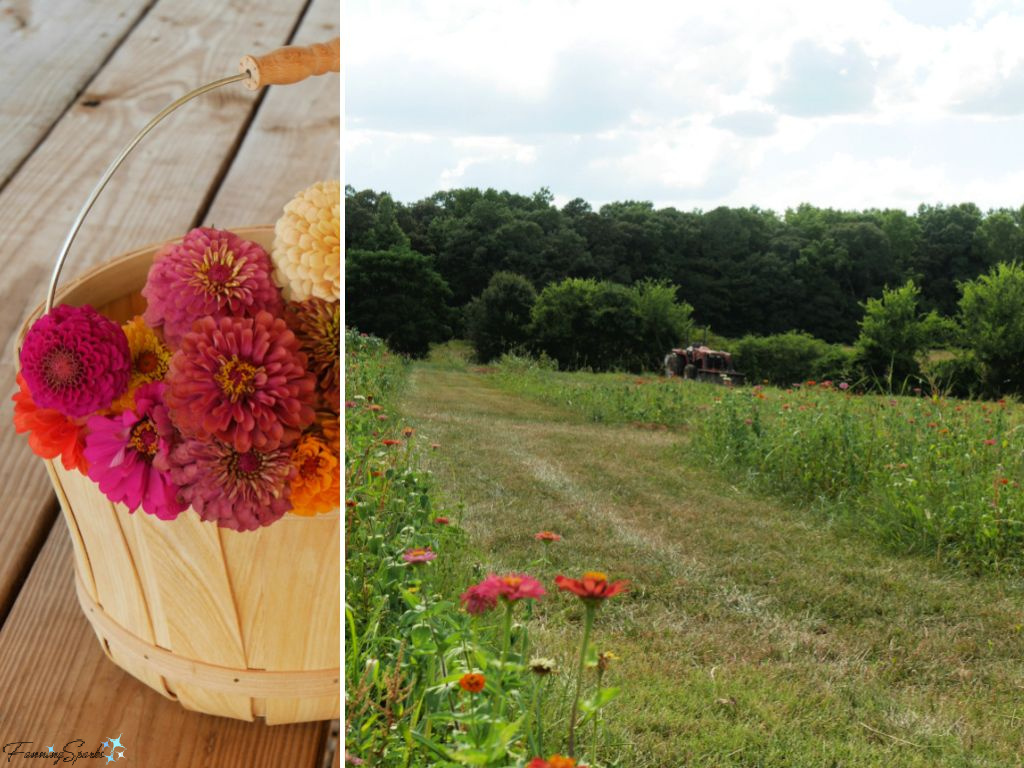
… or a peach orchard like this one I visited some time ago at Southern Belle Farm (see A Peach of a Day)…
 … or rows of blueberry shrubs like these at Doe Creek Farm (see Blueberry Zaniness)…
… or rows of blueberry shrubs like these at Doe Creek Farm (see Blueberry Zaniness)…
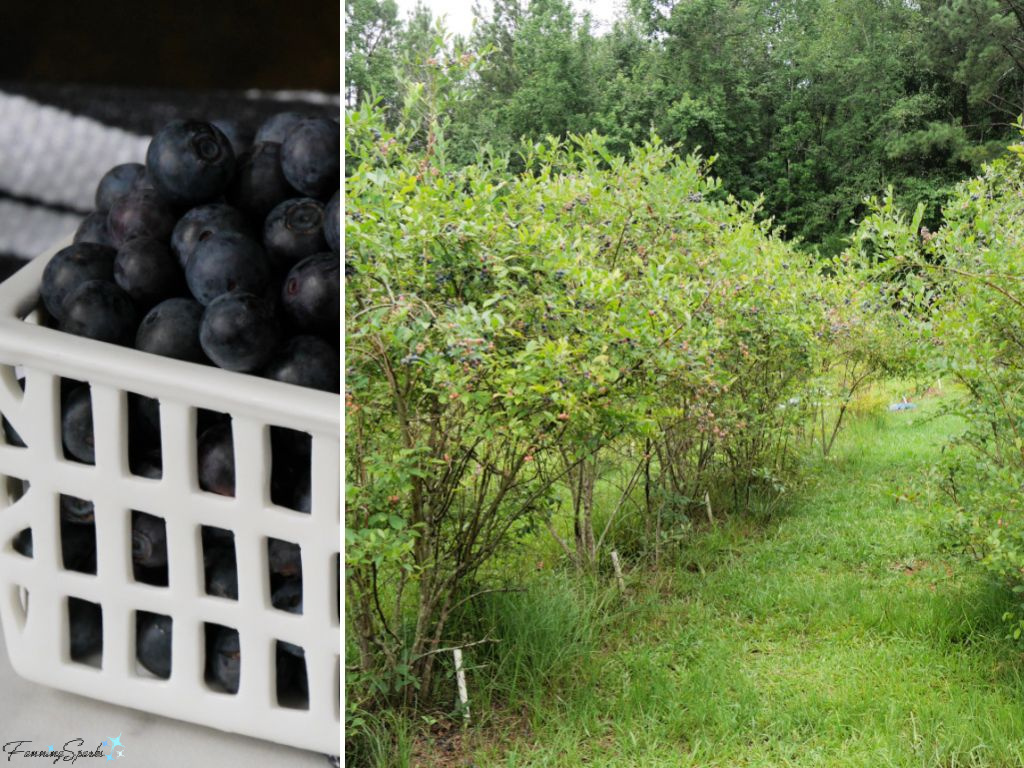
… or a glorious field of sunflowers like these at Farmview Market (see In the Sunflower Field).
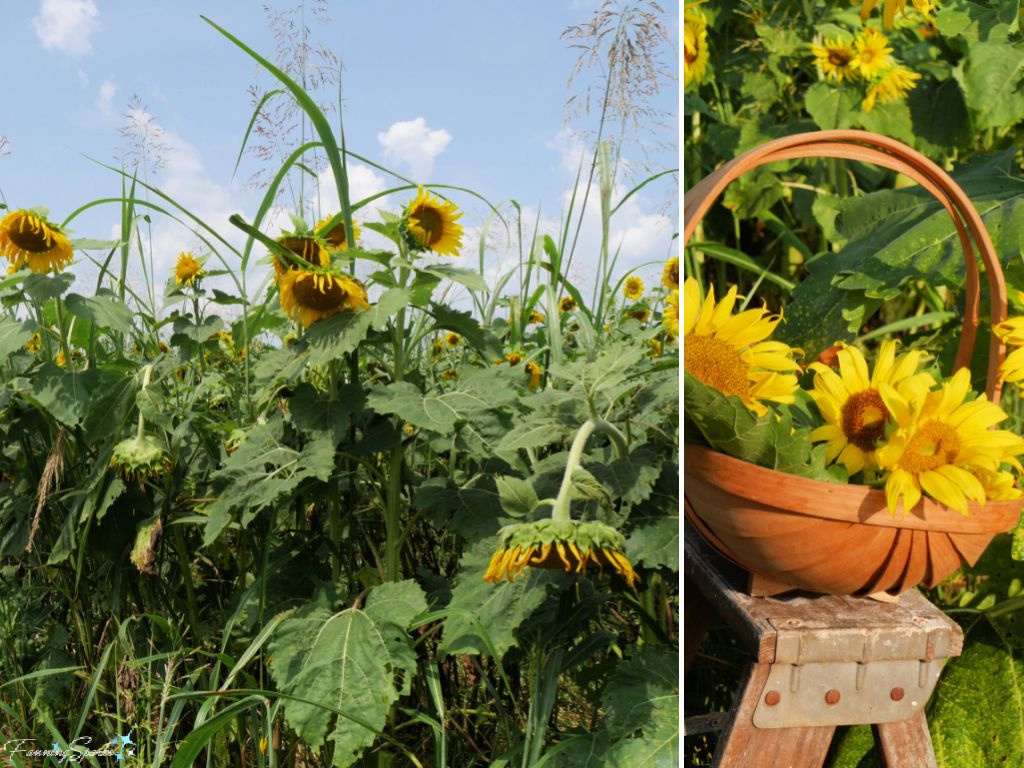 Pick-your-own operations are an effective response to consumers’ rising awareness of local food sources. They provide a direct link between the people growing the food and the people consuming it. U-Picks are a popular option in the growing trend of agritourism. See my previous blog post, A Weekend of Farm Tours, for a brief overview of the business of engaging, entertaining and educating visitors on farms and in other agricultural settings.
Pick-your-own operations are an effective response to consumers’ rising awareness of local food sources. They provide a direct link between the people growing the food and the people consuming it. U-Picks are a popular option in the growing trend of agritourism. See my previous blog post, A Weekend of Farm Tours, for a brief overview of the business of engaging, entertaining and educating visitors on farms and in other agricultural settings.
Every U-Pick operation is different but they all have the same basic premise―members of the public come to the farm, pick their own produce and pay for the bounty they carry home. Open days are scheduled around the crop’s ripeness so produce is at its peak when visitors arrive.
U-Pick Strawberries at Washington Farms
Washington Farms, in Bogart, Georgia, has been growing strawberries for over 20 years. Their U-Pick strawberry business is a well-orchestrated operation. After paying an admission fee, visitors are shown a brief, instructional video explaining how to pick strawberries as well as the basic ground rules (eg only pick the ripe berries and no eating while picking). Clear signage, and helpful staff members, guide pickers to the day’s locations.

Washington Farms grows their strawberries in raised rows with concealed irrigation.
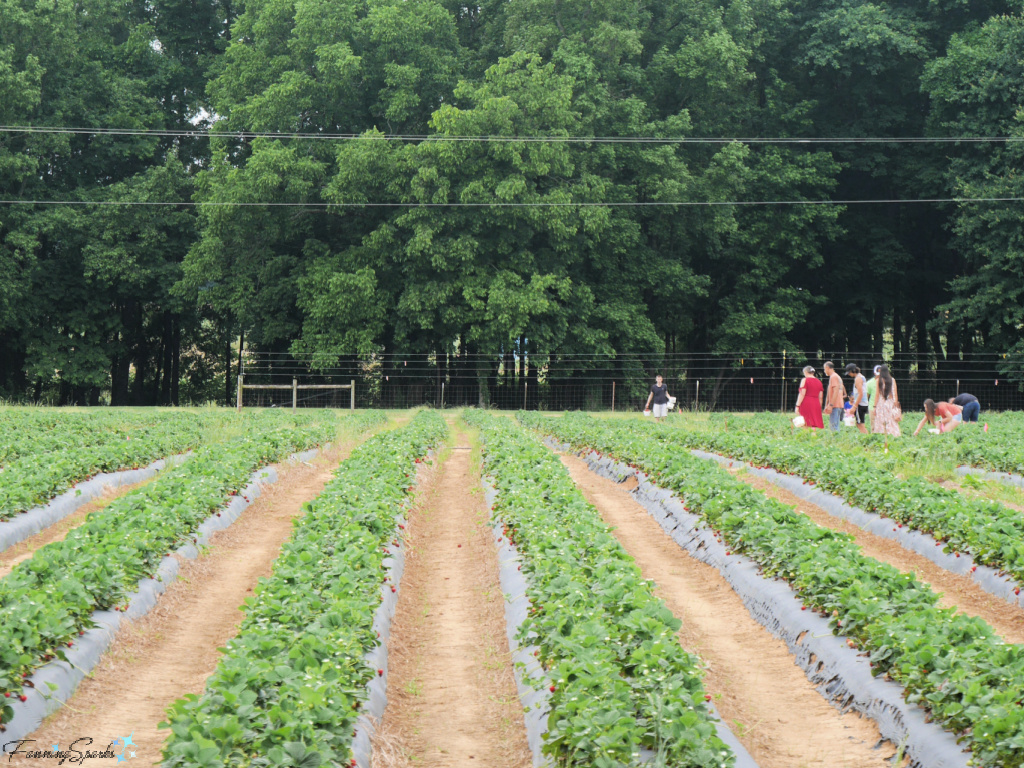 The plants are surrounded by black plastic sheeting making it easy to spot and pick the ripe berries.
The plants are surrounded by black plastic sheeting making it easy to spot and pick the ripe berries.
 All the hard work of soil preparation, planting, watering, weeding and nurturing has been done for you. In a way, it seems like cheating to arrive when the berries are at this stage. Picking season is, after all, a very short period towards the end of a full year of cultivating the crop.
All the hard work of soil preparation, planting, watering, weeding and nurturing has been done for you. In a way, it seems like cheating to arrive when the berries are at this stage. Picking season is, after all, a very short period towards the end of a full year of cultivating the crop.
If you look around, you may see farm machinery or other evidence of the work that goes into getting the strawberries to this stage.

Working my way along the row of luscious, ripe strawberries as I carefully filled my bucket was very relaxing.
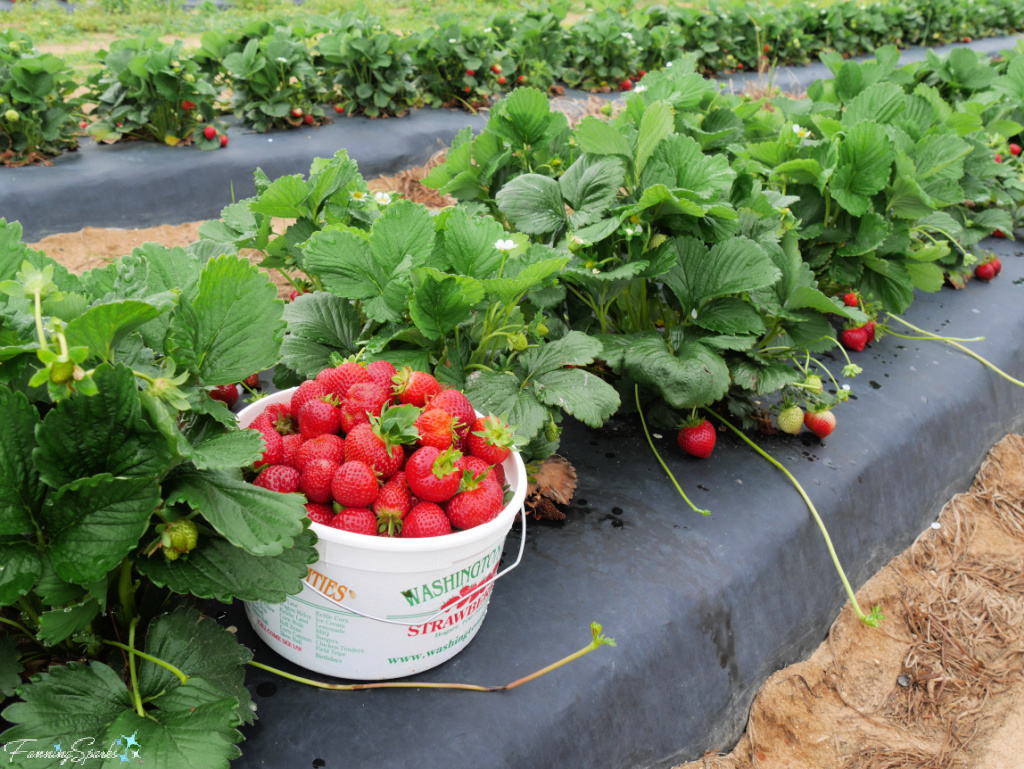
This Washington Farms’ strawberry slushie was the perfect way to wrap up my picking excursion.
 U-Pick Flowers at Big Hart Farm
U-Pick Flowers at Big Hart Farm
My visit to Big Hart Farm, a pick-your-own flower farm in Hartwell, Georgia, was prompted by a special event―the June Floral Harvest and Design Class. Billed as an opportunity to “discover the artistry of floral design amidst the vibrant blooms of our flower farm”, it promised “an hour of immersive harvesting in nature’s bounty, followed by an hour of expert instruction in creating stunning floral arrangements with your fresh harvest”.
We did indeed get to enjoy a rainbow of flowers, primarily zinnias, in full bloom.
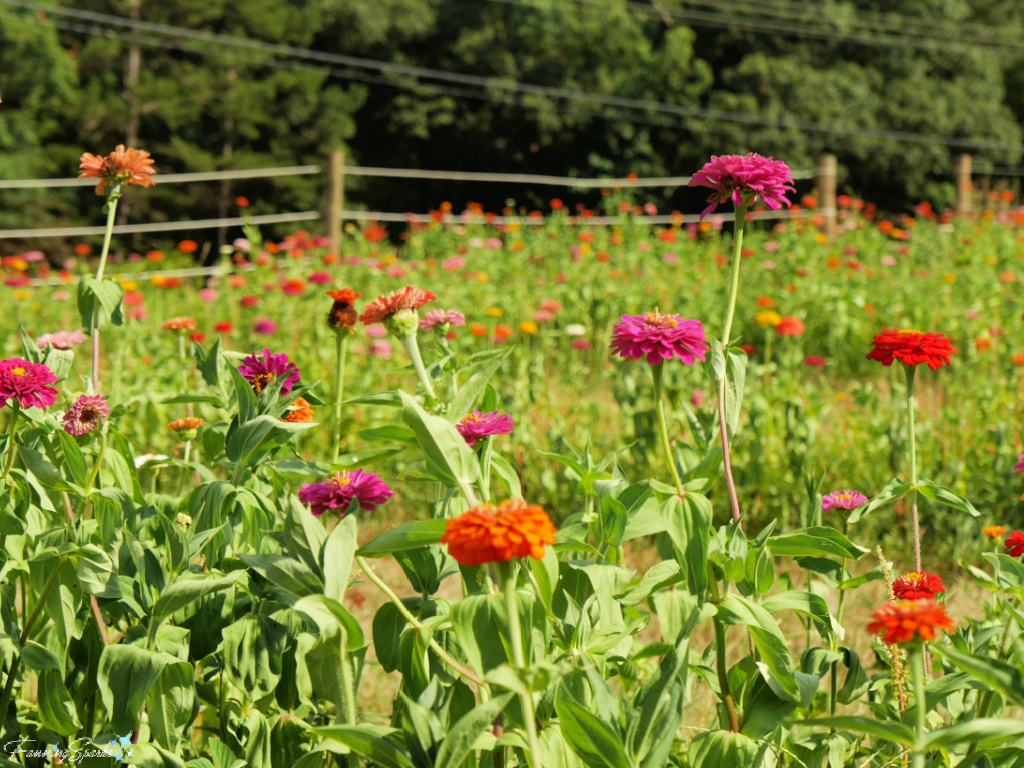 Regular readers may recall I have a special fondness for zinnias (see Zinnias Rock! And More Cutting Garden Tips). Often described as a “cut-and-come-again” flower, each zinnia plant produces multiple blooms during the season. They also attract butterflies such as the Variegated Fritillary (Euptoieta Claudia) shown below.
Regular readers may recall I have a special fondness for zinnias (see Zinnias Rock! And More Cutting Garden Tips). Often described as a “cut-and-come-again” flower, each zinnia plant produces multiple blooms during the season. They also attract butterflies such as the Variegated Fritillary (Euptoieta Claudia) shown below.
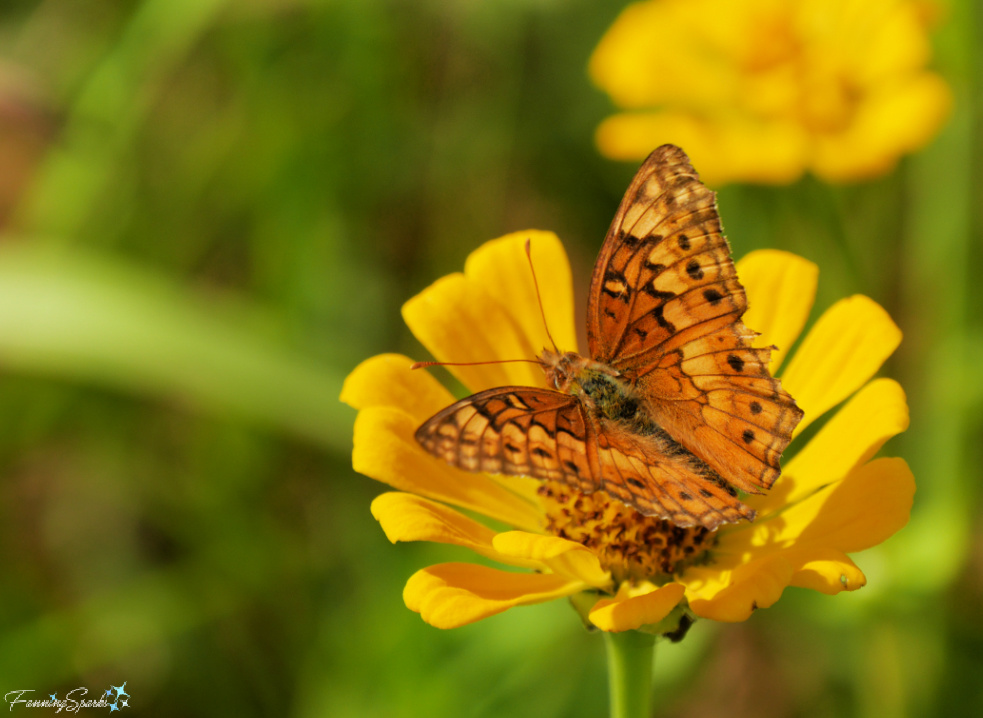
I still grow zinnias in my cutting garden but seeing an entire field full of them was amazing! As Maggie Jackson, farm owner and workshop leader, explained there are 40,000 zinnias and 15,000 sunflowers planted on 4 acres at Big Hart Farm!
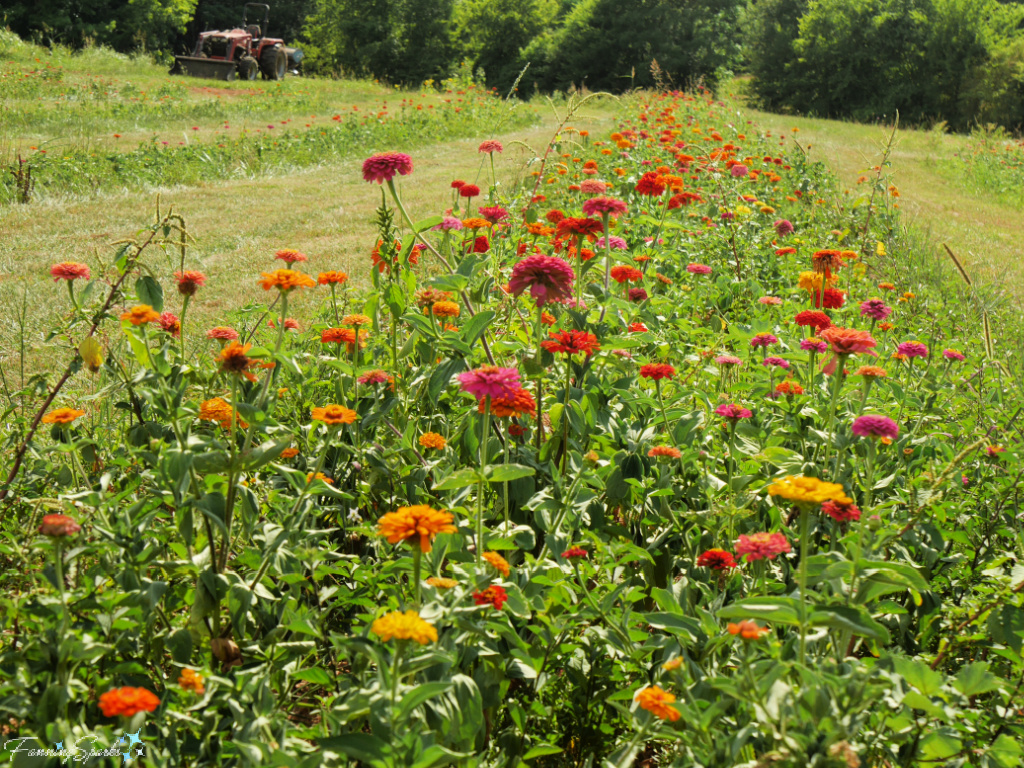
If I remember correctly, Maggie grows primarily three varieties of zinnias―Benary’s Giant, Cactus and Queeny. The Queeny zinnia flowers were showstoppers with double and semidouble blooms in gorgeous shades of rose, orange, peach, lemon, and lime.
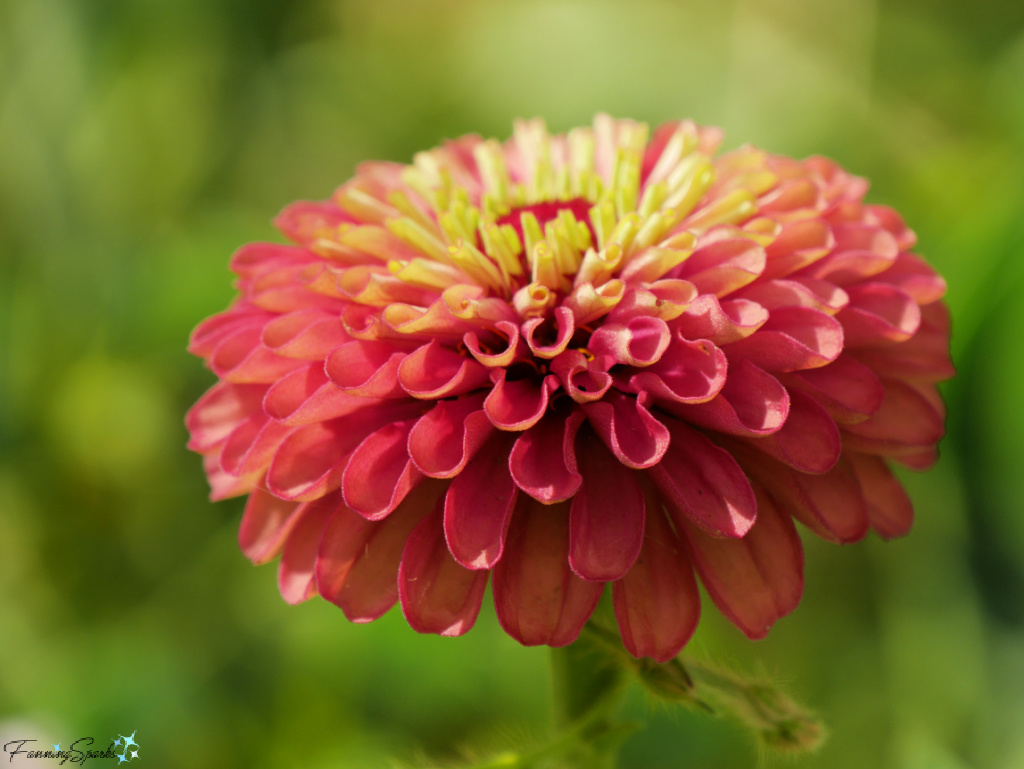
Our workshop was hosted in the welcome shade of Big Hart Farm’s pole barn.

After a friendly introduction and a few helpful cutting tips, we were invited to pick zinnia blooms for our bouquets. Shown below is my picking basket with a colorful assortment of zinnia blooms.
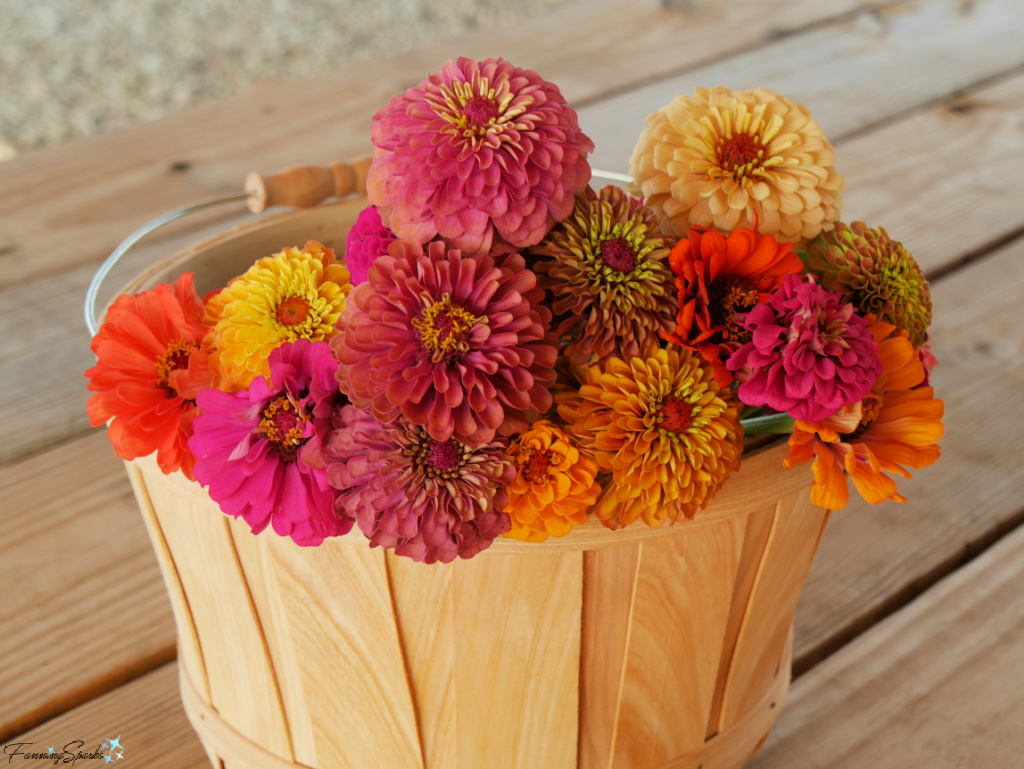
Next, we walked over to the sunflower field.

It was a little early in the season, but we easily found enough sunflowers for our bouquets.
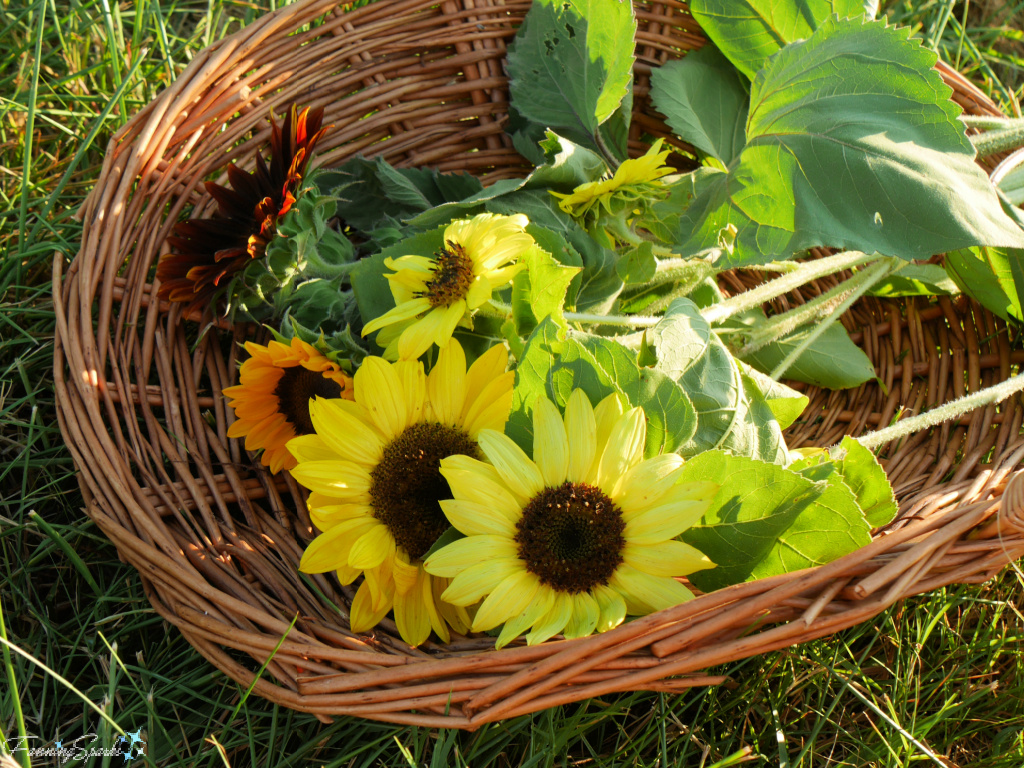
We concluded our flower harvest in the wildflower field where we found a variety of delicate blooms including cosmos, coreopsis and cornflowers.


Back in the pole barn, we processed our cut flowers removing the bottom leaves and trimming the stems.
TIP: There are many different theories on how to extend the life of cut flowers. At Big Hart Farm, they use “harvest water” for the first 8-12 hours to get the stems drinking after cutting. It is made by adding a solution, such as Chrysal Hydrating Solution, to water. The idea is to leave the flowers in this “hydration solution for no more than 48 hours post-harvest, at which time they should be moved to a holding solution containing carbohydrates” explains Johnny’s Selected Seeds website.
We used Mason jars to arrange our blooms into simple, casual bouquets. We started by placing our zinnias in the jar letting their sturdy stems crisscross to serve as a base for the bouquet. Then we added the sunflowers to build out the base. Next, we added the delicate wildflowers to fill in around the more dominant blooms. We finished off with sprigs of cress for a feathery, light touch of greenery.
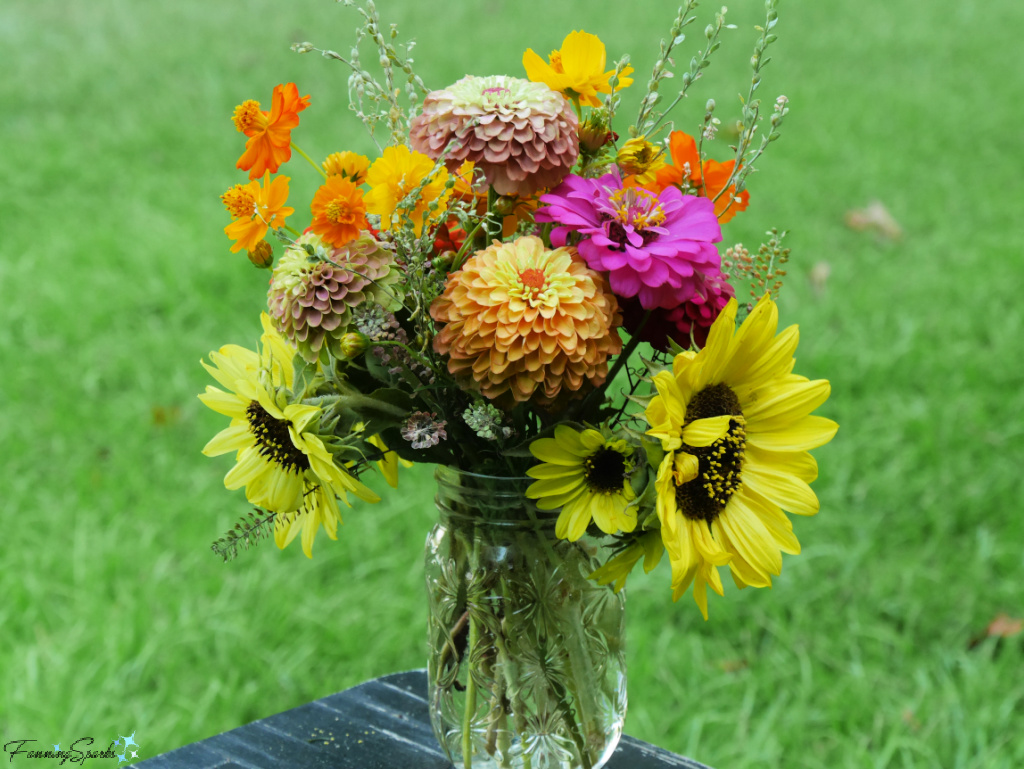
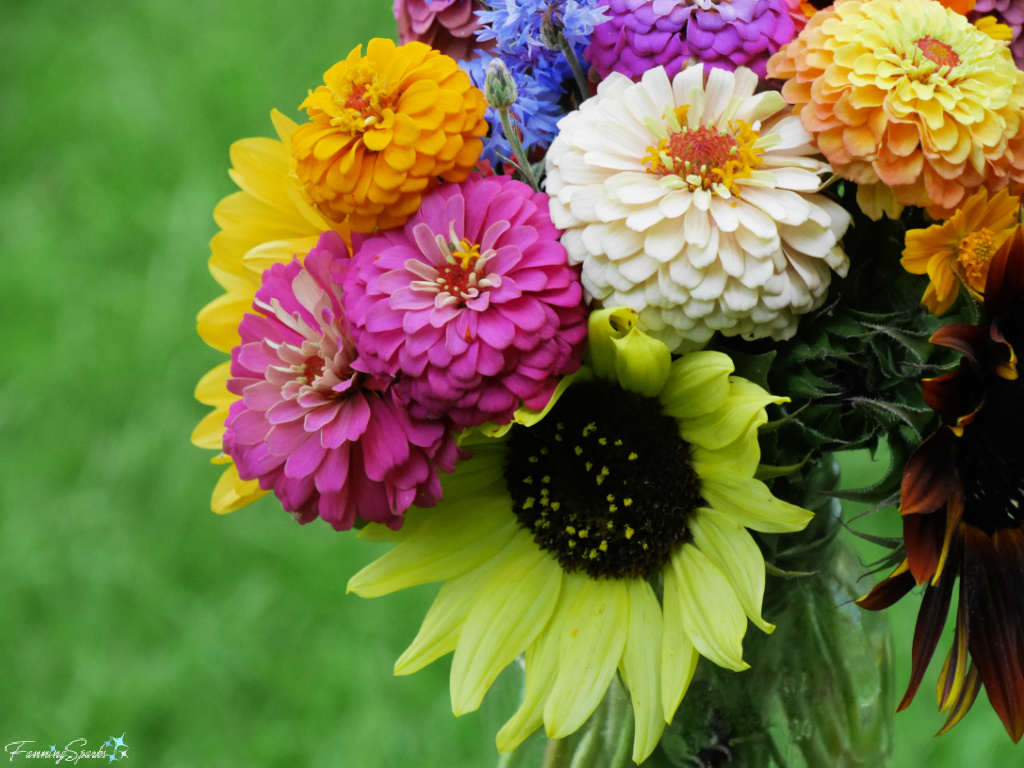
If you’ve never been to a pick-your-own flower farm you may wonder how it works. Here are some tips on etiquette and farm rules from Big Hart Farm’s blog post A Beginner’s Guide to You-Pick Flower Farms: Blooms, Tips, and Delights to “enhance your … experience …[and] contribute to the sustainability and enjoyment of the farm for all visitors…
. Show respect by honoring the farm and its stewards. Recognize the hard work and dedication that goes into maintaining the farm and treat the surroundings with care and appreciation.
. Harvesting with care is paramount; follow guidelines for responsible flower picking to avoid damaging plants and preserve the beauty of the fields for future visitors.
… Understanding pricing structures and payment methods beforehand helps streamline your experience and prevents any misunderstandings during checkout.
. Additionally, familiarize yourself with farm-specific rules before arriving to ensure compliance and smooth interactions with staff. Whether it’s guidelines regarding pet policies or designated picking areas, knowing what to expect ahead of time fosters a positive atmosphere and contributes to a memorable visit ”.
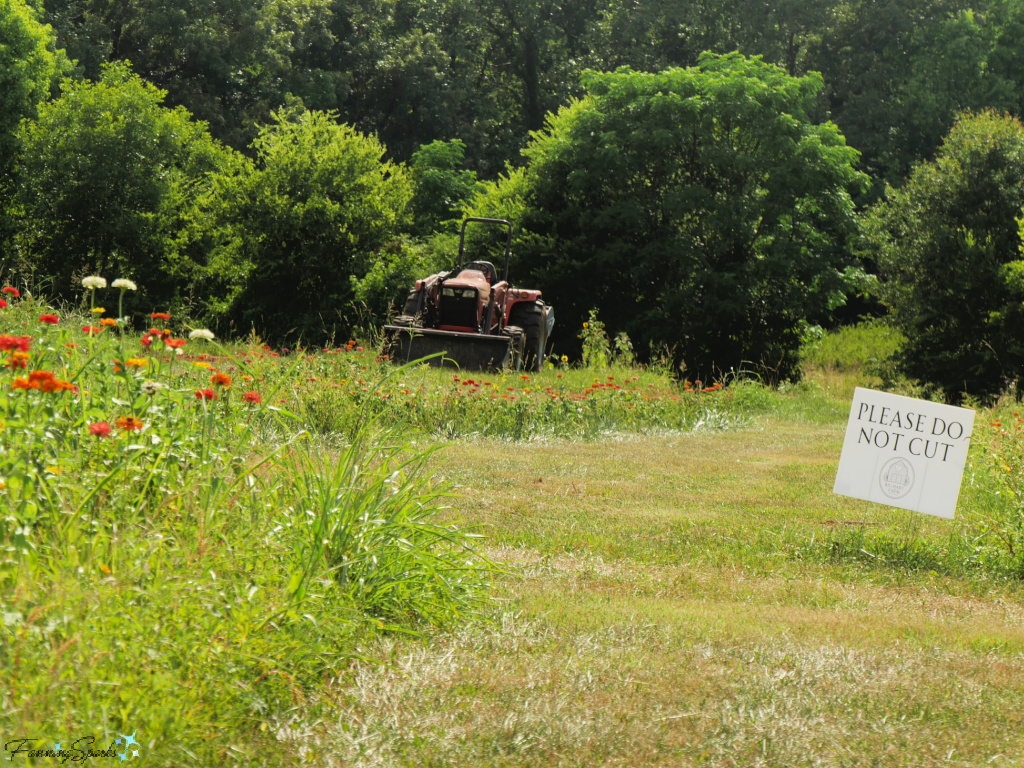
I really enjoyed spending time at Big Hart Farm. The workshop was great fun. We had a very small group so the class was relaxed and informal. Maggie was the perfect host, instructor and guide. She and her team shared their knowledge and expertise freely. Many thanks to everyone at Big Hart Farm for a terrific pick-your-own farm and workshop experience!
More Info
Previous blog posts mentioned in today’s blog post include:
. A Peach of a Day
. Blueberry Zaniness
. In the Sunflower Field
. A Weekend of Farm Tours
. Zinnias Rock! And More Cutting Garden Tips.
Check out the new AGRITOURISM sub-category in the TRAVEL section of the FanningSparks’ blog for an easy way to access all the blog posts about farm tours, U-Pick excursions, barnyard photo shoots and so on.
Washington Farms is located in Bogart, Georgia. They offer U-Pick strawberries in the spring as well as various harvest activities in the fall. Check out the Washington Farms website or Instagram page to learn more.
Big Hart Farm is located in Hartwell, Georgia. They offer U-Pick flowers in the summer as well as various harvest activities in the fall. Check out the Big Hart Farm website or Instagram page to learn more. You may also want to check out the Big Hart Farm blog post A Beginner’s Guide to You-Pick Flower Farms: Blooms, Tips, and Delights.
The following resources were consulted in the writing of this blog post:
. Johnny’s Selected Seeds website.
. Georgia Grown website for information about Pick Your Own agritourism in Georgia.
Today’s Takeaways
1. Consider supporting a local U-Pick farm.
2. Get close to nature by picking your own fruit, vegetables or flowers.
3. Picking your own produce is a good reminder of where food comes from.


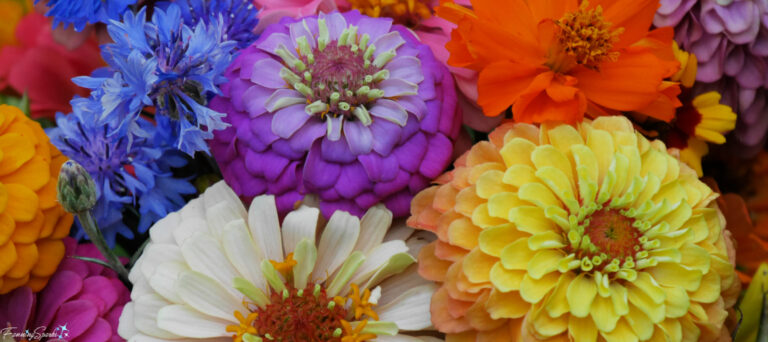


Comments are closed.